Bali garden design brings a unique blend of lushness and tranquility to outdoor spaces. With its tropical climate and diverse flora, Bali is renowned for its stunning gardens that inspire relaxation and connection with nature. From vibrant blooms to serene water features, this guide offers over 25 ideas to help you create your very own slice of paradise.
Utilizing Natural Stone Pathways

Natural stone pathways are a fantastic way to enhance the beauty of a Bali garden. These pathways not only guide visitors through the lush greenery but also add a rustic charm to the landscape.
The image showcases a winding path made of irregular stone pieces, surrounded by vibrant tropical plants. This design invites you to take a leisurely stroll, enjoying the serene environment.
Using natural stone creates a seamless connection between the garden and the home. The earthy tones of the stones blend perfectly with the greenery, making the space feel cohesive and inviting.
Consider incorporating curves in your pathway design. Curved paths can create a sense of mystery, encouraging exploration and discovery within your garden.
Adding borders with low-maintenance plants can enhance the pathway’s appeal. Plants like ferns or small shrubs can soften the edges and create a lush frame for the stones.
Creating Serenity with Water Features
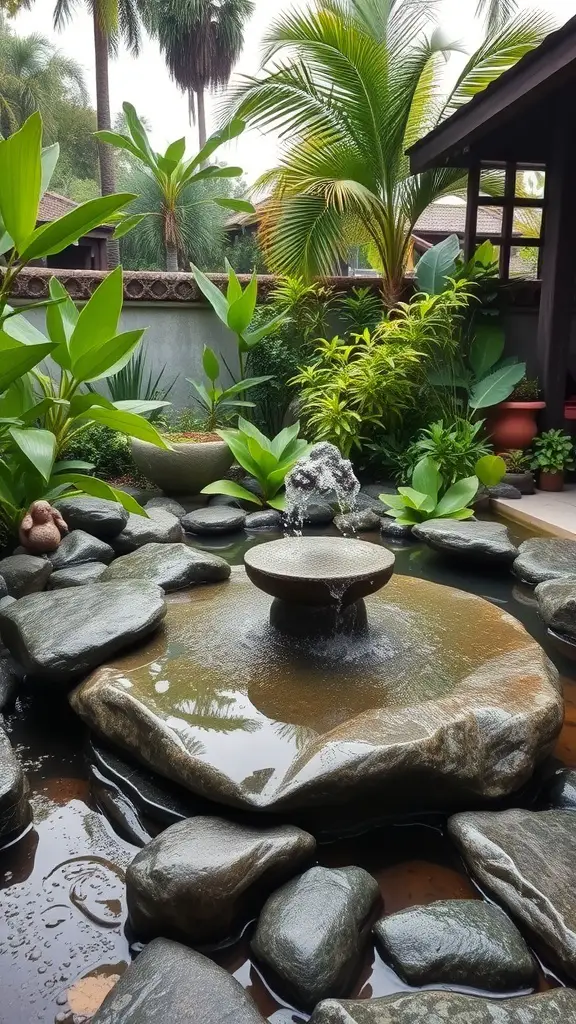
Water features can transform any garden into a peaceful retreat. In Bali, the use of water is especially prominent, creating a calming atmosphere that invites relaxation.
The image showcases a beautiful water feature surrounded by lush greenery. The gentle flow of water adds a soothing sound, making it a perfect spot to unwind.
Notice the smooth stones that frame the water, enhancing the natural look. This design encourages a connection with nature, making it easy to forget the stresses of daily life.
Incorporating plants like palms and ferns around the water feature not only adds color but also creates a sense of privacy. This combination of elements fosters a serene environment, ideal for meditation or simply enjoying a quiet moment.
Designing Cozy Outdoor Living Spaces
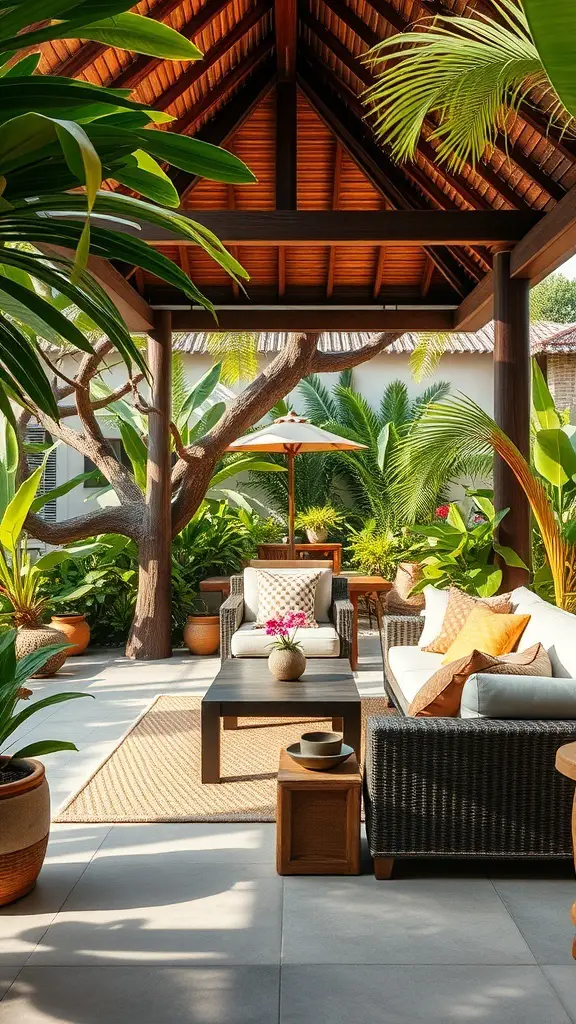
Creating a cozy outdoor living space can transform your garden into a welcoming retreat. The image shows a lovely setup with comfortable seating surrounded by lush greenery. This kind of design invites relaxation and socializing.
The use of natural materials, like wood and stone, adds warmth. The thatched roof provides shade, making it perfect for sunny days. Incorporating plants enhances the connection to nature, making the space feel alive.
Consider adding soft cushions and throws to the seating for extra comfort. A coffee table in the center can serve as a gathering spot for drinks or snacks. Lighting, like lanterns or string lights, can create a magical atmosphere in the evenings.
Don’t forget about the layout! Arranging furniture to encourage conversation can make the space feel more inviting. A rug can define the area, adding texture and warmth underfoot. Overall, this design showcases how to blend comfort and style in outdoor spaces.
Tropical Plant Selection for Bali Gardens
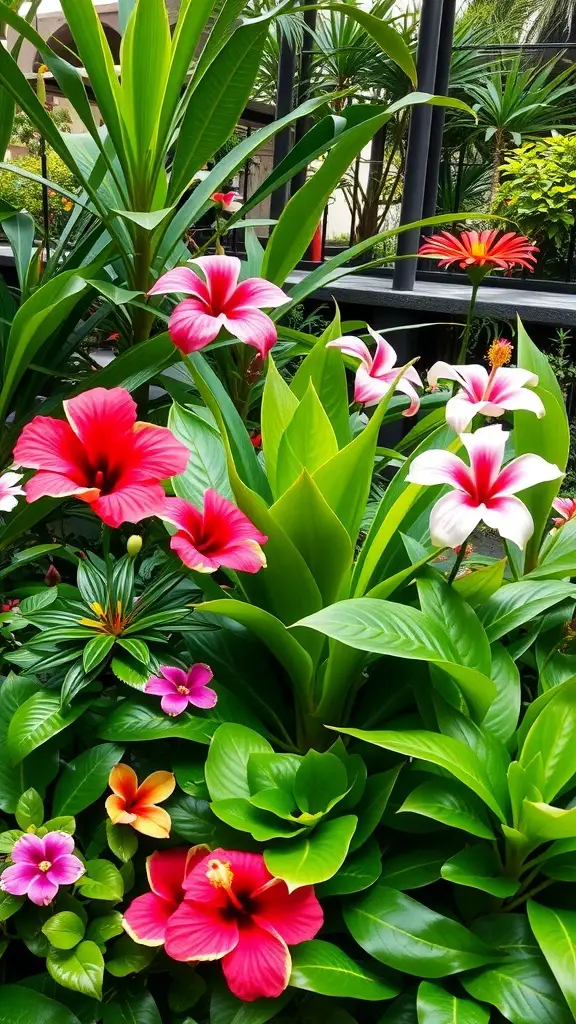
Bali gardens thrive on vibrant tropical plants that bring life and color to outdoor spaces. The image showcases a stunning array of flowers and lush greenery, perfect for creating a tropical paradise.
Hibiscus flowers, with their bold colors, are a fantastic choice for adding a pop of brightness. Their large blooms can instantly uplift any garden. Pair these with leafy plants that provide a rich backdrop, enhancing the overall look.
Consider incorporating plants like bird of paradise or frangipani, which are not only beautiful but also well-suited to Bali’s climate. These plants can create a lush, tropical feel that invites relaxation.
Mixing different textures and colors is key. The combination of vibrant flowers and rich green leaves creates a visually appealing contrast. This approach helps to create depth and interest in your garden.
Lastly, remember to choose plants that thrive in the local environment. This ensures your garden remains healthy and vibrant year-round. With the right selection, your Bali garden can become a true tropical escape.
Balinese Bamboo Structures as Garden Features
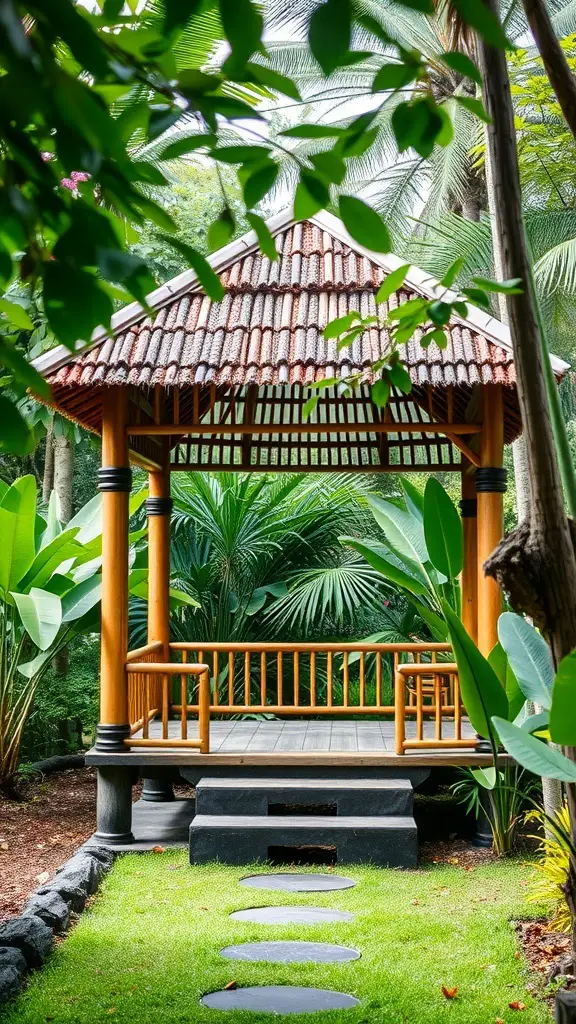
Imagine stepping into a garden that feels like a tropical paradise. The centerpiece is a stunning bamboo structure, often called a gazebo or bale. These traditional Balinese designs blend seamlessly with nature, creating a cozy spot to relax or entertain.
The bamboo used in these structures is not just beautiful; it’s also strong and sustainable. This makes it a perfect choice for outdoor settings. The open design allows for plenty of airflow, keeping the space cool even on warm days.
Surrounding the bamboo structure are lush green plants, adding to the serene vibe. Large leaves and colorful flowers create a vibrant backdrop, making the area feel alive. Pathways made of smooth stones lead you right to the entrance, inviting you to explore further.
These garden features are more than just pretty spots; they serve as gathering places for family and friends. Whether it’s a quiet morning coffee or a lively evening gathering, a Balinese bamboo structure enhances any outdoor experience.
Incorporating Balinese Statues and Sculptures
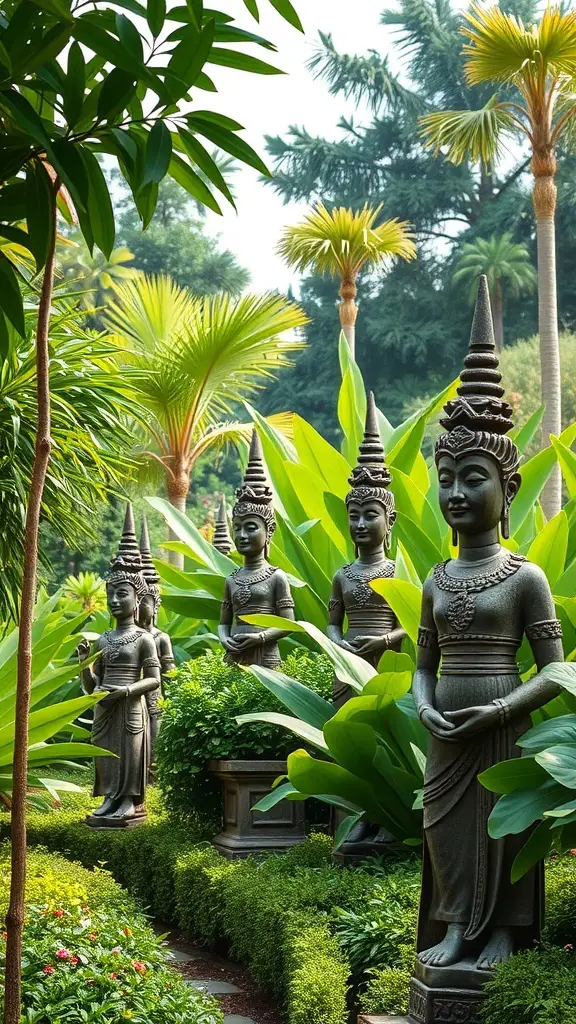
Balinese statues and sculptures add a unique charm to garden spaces. These artistic pieces often reflect the rich culture and spirituality of Bali. Imagine walking through a garden filled with lush greenery and encountering beautifully crafted statues that tell a story.
In the image, you can see several statues standing gracefully among vibrant plants. Their intricate designs and serene expressions create a peaceful atmosphere. This setup invites you to pause and appreciate the beauty around you.
When designing your garden, think about how these sculptures can enhance your space. They can serve as focal points or subtle accents, depending on your style. You might choose statues that resonate with you personally or reflect themes like tranquility and harmony.
Consider placing these statues along pathways or near water features. This positioning can create a sense of flow and connection within the garden. Pairing them with tropical plants can further emphasize that Balinese vibe, making your outdoor area feel like a serene retreat.
Integrating Colorful Flower Beds
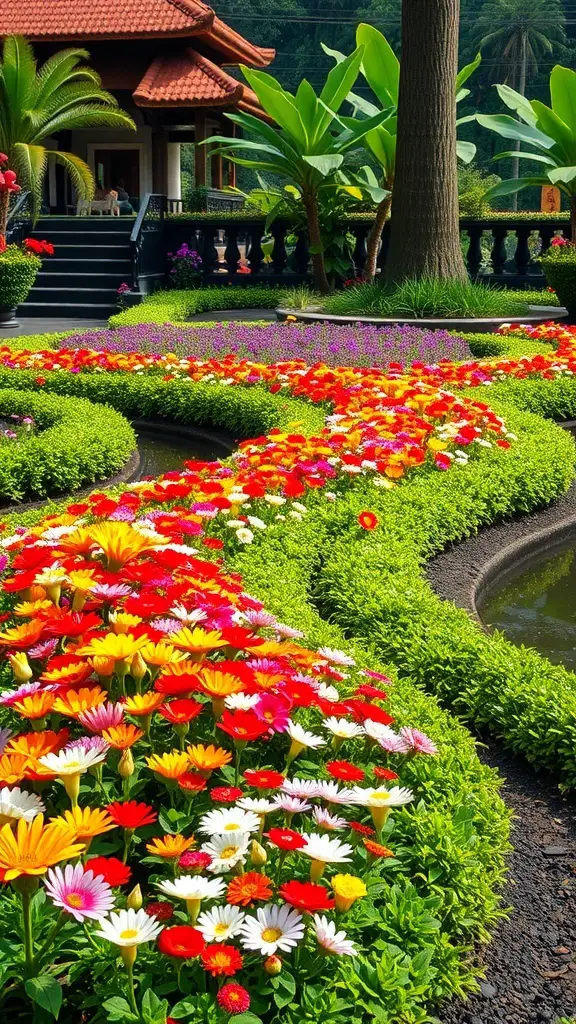
Creating a vibrant garden in Bali often starts with colorful flower beds. These beds can bring life and energy to any outdoor space. Imagine walking through a garden filled with bright reds, yellows, and pinks, all blooming together.
In the image, you can see a stunning arrangement of flowers that flow gracefully along the garden path. The mix of colors creates a cheerful atmosphere. This design invites visitors to explore and enjoy the beauty of nature.
When planning your own flower beds, think about using a variety of flowers that bloom at different times. This way, your garden will have color throughout the year. Pairing flowers with lush greenery can also enhance the overall look.
Consider adding pathways that wind through the flower beds. This creates a sense of movement and encourages people to wander and appreciate the blooms. Incorporating local plants can also help your garden blend seamlessly with the surrounding environment.
Creating Shade with Canopy Trees
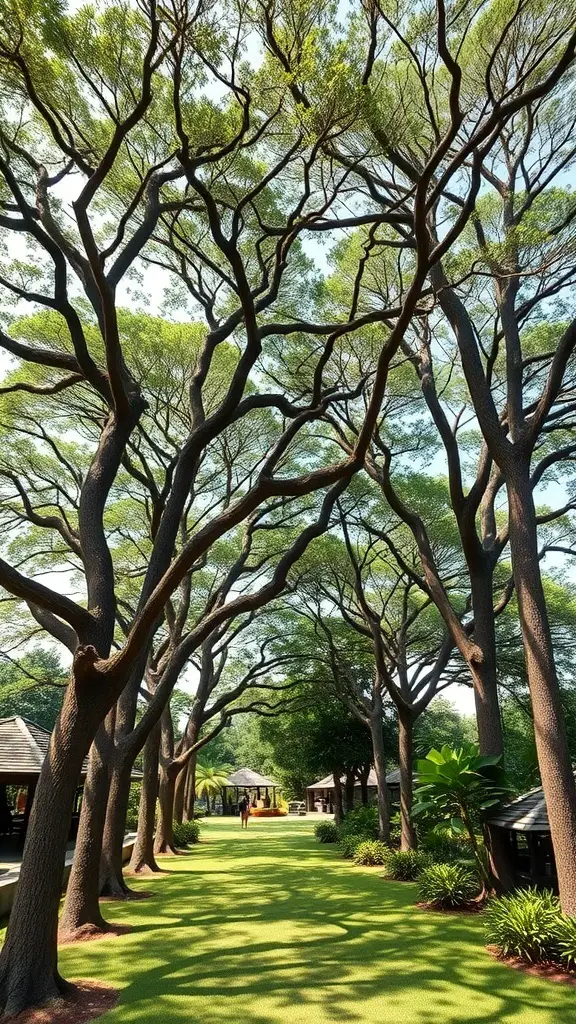
Canopy trees play a vital role in garden design, especially in tropical locations like Bali. They provide much-needed shade, making outdoor spaces comfortable even during the hottest days. The image captures a beautiful row of tall trees with sprawling branches, creating a natural ceiling that filters sunlight.
These trees not only offer shade but also add a sense of tranquility to the garden. Walking beneath their branches can feel refreshing, as the dappled light dances on the ground. This kind of setting is perfect for relaxation or social gatherings.
Incorporating canopy trees into your garden design can enhance the overall aesthetic. They can serve as focal points or frame pathways, guiding visitors through the space. Choosing the right species is key, as some trees grow faster than others and can adapt better to local conditions.
Consider planting a mix of trees to create layers and depth in your garden. This variety can attract different wildlife, adding life to your outdoor area. Overall, canopy trees are a fantastic addition to any Bali garden, providing shade, beauty, and a peaceful atmosphere.
Balancing Hardscape and Softscape Elements
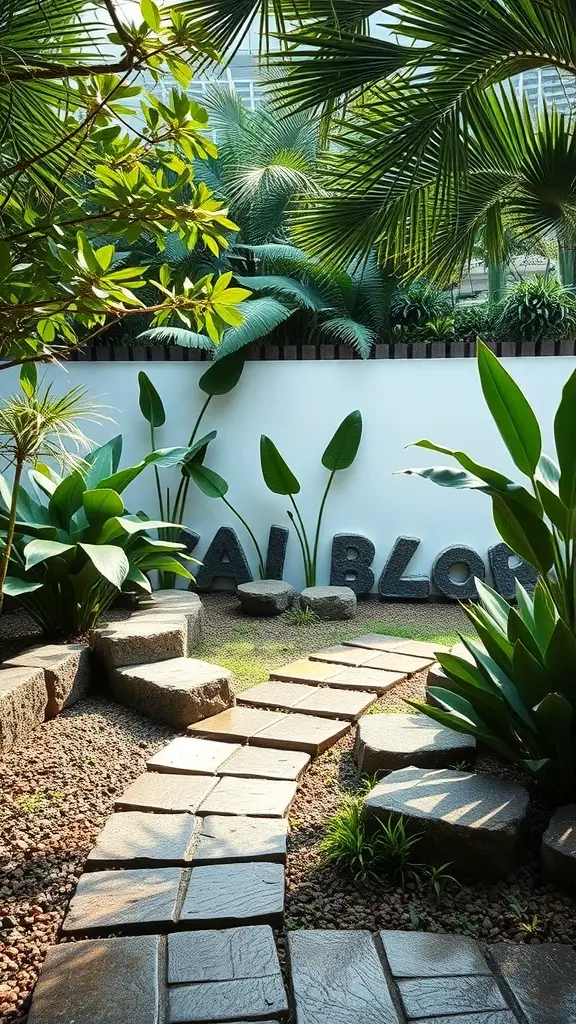
In Bali garden design, the mix of hardscape and softscape is key. Hardscape includes the stones and pathways, while softscape refers to the plants and greenery. This image shows a beautiful balance between these elements.
The stone pathway invites you to explore the garden. It leads through lush greenery, creating a sense of flow. The large leaves and tropical plants add life and color, making the space feel vibrant.
The use of natural materials like stone enhances the garden’s connection to nature. The contrasting textures of the hard surfaces and soft plants create visual interest. This combination makes the garden not just a space to walk through, but a place to enjoy and relax.
Incorporating both hardscape and softscape thoughtfully can transform any outdoor area into a peaceful retreat. Consider how these elements work together to create harmony in your own garden.
Enhancing Privacy with Lush Hedges
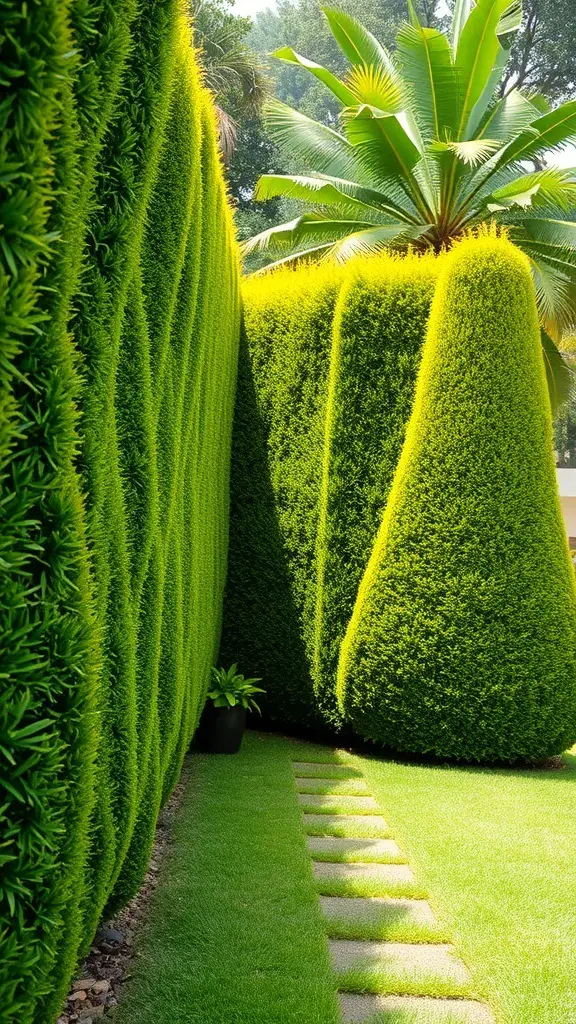
Creating a private space in your garden can be a game changer. Lush hedges serve as natural barriers, offering both beauty and seclusion. The image showcases a stunning arrangement of neatly trimmed hedges that not only provide privacy but also add a vibrant touch to the landscape.
The bright green hues of the hedges contrast beautifully with the soft, manicured lawn. This combination creates a serene environment, perfect for relaxation or entertaining guests. The unique shapes of the hedges add an artistic flair, making the garden visually appealing.
Incorporating hedges into your garden design can be simple. Choose varieties that thrive in your climate and consider their growth patterns. With the right care, these plants can flourish, enhancing your outdoor space while ensuring your privacy.
Sustainable Practices in Bali Garden Design
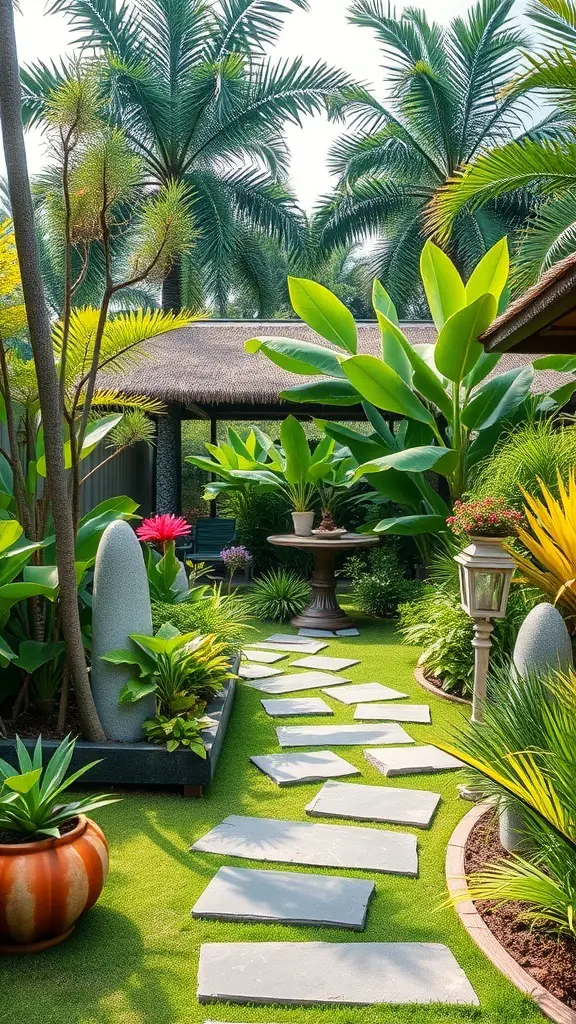
Bali is known for its lush landscapes and vibrant gardens. The image showcases a beautifully designed garden that reflects sustainable practices. The pathway made of stones leads through a variety of tropical plants, creating a serene atmosphere.
Using native plants is a key aspect of sustainability. These plants thrive in the local climate and require less water and maintenance. The garden features large leaves and colorful flowers, which not only add beauty but also support local wildlife.
Incorporating natural materials, like stone and clay pots, helps blend the garden with its surroundings. This approach reduces the carbon footprint and promotes eco-friendly design. The use of decorative elements, such as the birdbath, encourages biodiversity by attracting birds and beneficial insects.
Another important practice is water conservation. The garden design likely includes efficient irrigation systems or rainwater harvesting. This ensures that plants receive the moisture they need without wasting water.
Overall, this Bali garden exemplifies how to create a stunning outdoor space while respecting the environment. It’s a perfect example of how beauty and sustainability can go hand in hand.
Incorporating Local Cultural Elements

Bali gardens are not just about plants; they reflect the rich culture of the island. The image shows a beautiful setup with lush greenery and traditional Balinese decor. The vibrant colors and textures create a warm and inviting space.
Notice the woven baskets and pottery, which are common in Balinese homes. These elements add authenticity and charm. The use of natural materials connects the garden to the local environment.
The red fabric hanging in the background is a nod to traditional Balinese ceremonies. It adds a pop of color and symbolizes good fortune. Incorporating such cultural elements makes the garden feel more personal and meaningful.
Consider adding local plants like frangipani or bamboo to enhance the tropical vibe. These plants not only beautify the space but also hold cultural significance in Bali.
Seasonal Planting for Year-Round Beauty
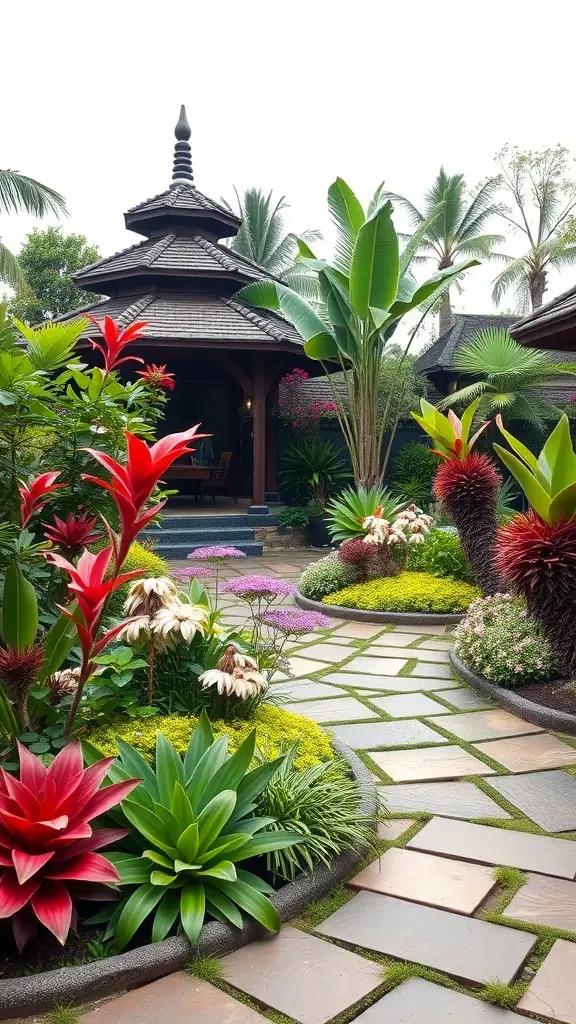
Creating a stunning garden in Bali involves thoughtful seasonal planting. The image showcases a vibrant garden filled with colorful flowers and lush greenery, perfect for inspiring your own outdoor space.
In this garden, tropical plants like bromeliads and palms thrive, providing a lush backdrop. The pathway made of stone adds a natural touch, guiding visitors through the beauty of the landscape.
Consider incorporating plants that bloom in different seasons. For instance, you might choose flowering plants that thrive in the wet season, alongside hardy varieties that flourish in the dry months. This way, your garden will always have something in bloom.
Mixing textures and colors can also enhance the visual appeal. Use bold, bright flowers alongside softer greens to create a balanced look. Don’t forget to include some ground cover plants to fill in spaces and add depth.
Lastly, think about the layout. Curved paths can create a sense of flow, inviting exploration. With careful planning, your garden can be a beautiful retreat all year long.
Lighting Techniques for Evening Ambiance
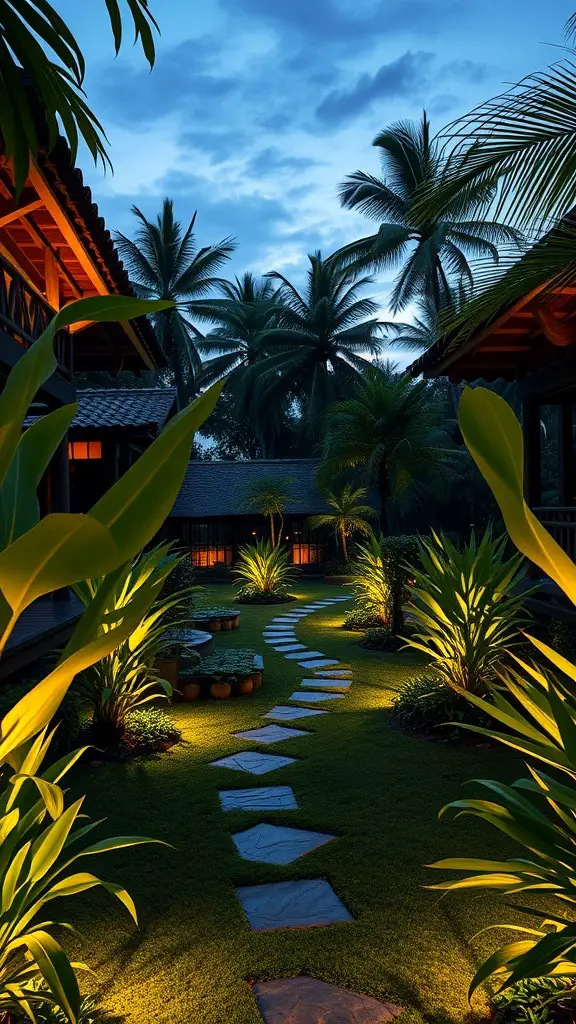
Creating a magical evening atmosphere in your Bali garden is all about the right lighting. The image shows a beautifully lit garden path, surrounded by lush greenery and soft lighting. This setup invites you to stroll through the space, making it feel warm and welcoming.
Pathway lighting is key. The stones are highlighted by subtle lights, guiding your way while adding charm. Consider using low-voltage lights or solar-powered options for an eco-friendly touch. They not only illuminate the path but also enhance the beauty of the plants.
Spotlights can be used to accentuate specific features, like a beautiful tree or a water feature. This draws the eye and creates focal points throughout the garden. Using warm-toned lights can mimic the natural glow of sunset, making the space feel cozy.
Don’t forget about the surrounding structures. Soft lighting on the walls of your home or garden structures can create a harmonious blend with nature. Lanterns or string lights can add a playful element, making the garden feel festive.
Lastly, consider the balance of light and shadow. Too much light can wash out the beauty of your plants. Aim for a mix that highlights key areas while allowing some parts to remain softly lit. This creates depth and interest in your garden.
Edible Gardens: Growing Tropical Fruits and Herbs

Imagine stepping into a garden filled with vibrant tropical fruits and lush greenery. This image captures the essence of an edible garden in Bali, showcasing a variety of fruits hanging from trees, surrounded by rich foliage. The colorful fruits, with their bright reds and yellows, invite you to explore the flavors of the tropics.
Creating an edible garden like this one can be a rewarding experience. Start by choosing tropical fruits that thrive in your climate. Fruits like papaya, mango, and passion fruit are excellent options. They not only add beauty to your garden but also provide delicious snacks right from your backyard.
Herbs are another fantastic addition. Consider planting basil, mint, and lemongrass. These herbs not only enhance your meals but also bring delightful scents to your garden. Pairing fruits and herbs can lead to unique culinary creations.
When planning your garden, think about the layout. Grouping plants with similar needs can help them thrive. Make sure to provide enough sunlight and water, as tropical plants often require both to flourish.
Lastly, enjoy the process! Gardening is not just about the end result; it’s about nurturing plants and watching them grow. So grab your gardening tools and start your own tropical paradise!




